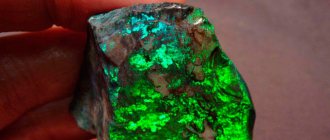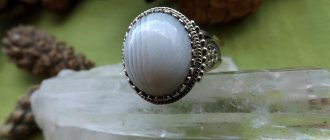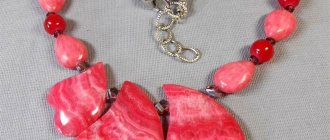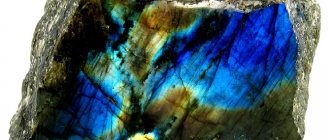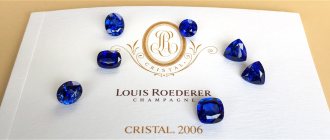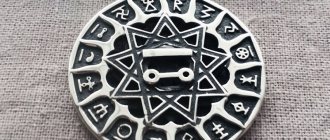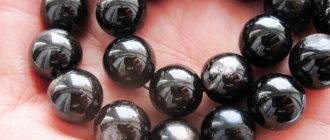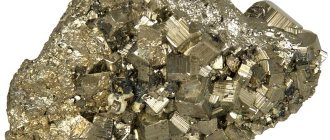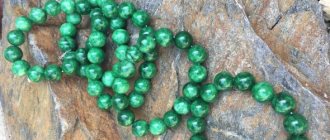Spinel is a trickster stone that has been featured on crowns for centuries, like its more expensive counterpart, the ruby.
Spinel surpasses ruby in its brilliance and depth.
It can be scarlet red, mysterious green, soft blue, deep green and even coal black. The beauty of a stone can only be outshone by the beauty of its history.
History and origin
The name of the stone - spinel - Spinell, came to us from the German language. The word may have Latin roots, from spina (“thorn”), which can be associated with pointed crystals, or Greek roots, from the word σπίν(ν)ος (“shine”).
Gem mining has been carried out since ancient times; the first information about mining in the Pamir Mountains from the 9th century came to us thanks to Marco Polo, a traveler of the 13th century. He called spinel deposits “ruby mines.” The fact is that all valuable red-pink gemstones were then called “lal”, without division: spinel, ruby, garnet, red tourmaline.
Spinel
This word, which has roots in the Hindi and Farsi languages, was passed down through generations in different ethnic groups for centuries, and was used in ordinary speech and trade until the 13th century, along with the collective concepts of other precious stones: yakhont and carbuncle. It was preserved in the folk epic. Then, until the 18th century, the name “lal” (“lal”) was used only in relation to red spinel as a stone inferior in its jewelry value to ruby, but superior to garnet and other red gems that fall into this group.
Due to its beauty, rich color, hardness and transparency, it is not easy to distinguish spinel from other stones of high jewelry value. This became possible only with the development of technology and chemical analysis. Only 150 years ago the stone received its name and deserved place among gems, and this became a period of exposure.
It turned out that collectors, in museums, in the crowns of European dynasties, in the treasuries of the Persian shahs, do not keep rubies, but beautiful examples of spinel.
The most famous spinel impostors:
- The stone on the crown of the Persian Shahs is from the treasury of the fallen Mughal Empire. The largest stone in history is 500 carats, accompanied by more than twenty 100 carat "pebbles".
- 170 carat spinel on the British Empire crown. Until the 20th century, this stone was known as the “Black Prince” ruby, bringing misfortune to all owners, until it strangely ended up in England.
- "Ruby of Timur" 361 carats, decorated with the names of six owners. Now belongs to the British Crown and is kept in Buckingham Palace.
- The treasuries of the Romanovs contained a royal “ruby” measuring 414 carats.
- The crown of the Russian Empire of Catherine II, the property of the Diamond Fund of Russia, is decorated with a spinel of 398.72 carats.
History of spinel stone
Spinel has been known to man for a very long time.
The first mentions of spinel date back to the 13th century. At that time, Marco Polo visited the Pamir mountains. It was here that the Kuhilala deposit was discovered. Since the 9th century, the mineral has been mined in this place. It is worth noting that it was mistakenly taken for corundum and ruby. For this reason, the deposit was called “ruby mines.” Over time, the gem was identified as an independent group of stones.
Spinel has always been revered. And its cost, due to its rarity, was very high. From historical information it is known that in 1762 it was used as decoration on the crown of Empress Catherine II. Dark red specimens were selected for its inlay. Similar stones decorated the Monomakh Cap.
At various times the gem was called “spinel”, “rubicel”, “lal”, “picotite” and “coelonite”. He was highly valued by the inhabitants of Rus'. In terms of value, it could be compared with minerals such as amethyst, emerald and sapphire. Modern stone jewelry is on a par with pearls and diamonds.
Physicochemical characteristics
MgAl2O4 - spinel has a high degree of isomorphism of the metals it contains: some of the magnesium and aluminum ions can be replaced by metal ions of comparable size without changing the basic properties.
Spinel
Magnesium ions are replaced by iron, sometimes zinc, and some of the aluminum is replaced by iron or chromium. Without affecting the basic properties in any way, this determines the color of the mineral.
| Formula | MgAl2O4 |
| Color | Colorless, red, pink, blue, green, violet, yellow |
| Shine | Glass |
| Transparency | Transparent to translucent |
| Hardness | 7,5—8 |
| Cleavage | Imperfect |
| Kink | Conchoidal |
| Density | 3.57—3.72 g/cm³ |
Description of the stone
The mineral consists of aluminum and magnesium oxides. It may contain other elements in the composition, which often determine the tone of the stone.
Black spinel is a hard but fragile gem. In nature it is represented by octagonal crystals up to 12 carats. Among the physical features are noted:
- stone hardness on the Mohs scale: 8 points;
- color: black, uniform, without inclusions;
- glass shine;
- transparent;
- fracture: conchoidal;
- cleavage: imperfect;
- density: 3.6-3.7 g/cm3
Mineralogists say that stone is not purely black.
Most often, impurities give one or another shade, which is why several varieties of black spinel are distinguished:
- noble - transparent crystals of deep black color;
- ordinary - matte stones with a high iron content of dark brown, dark green color;
- chrome, or picotite, is an opaque mineral of a dark green hue, in which aluminum is partially inferior to chromium;
- ganite is a rock containing iron and zinc instead of magnesium.
Watch a video about the mineral:
Place of extraction
Spinels form under high temperature conditions. Most of them are of no mineralogical value; some may be of industrial importance. Ores of titanium, iron and other metals, which are spinels, form physical indicators of the magnetic properties of rocks.
On the surface they are resistant to weathering, so they are mined in placers. They are found in single crystals measuring 10–12 carats, usually in the shape of an octahedron or dodecahedron. Sometimes they form drusen.
When talking about spinel deposits, we consider mining specifically the noble variety. As a rule, crystals are small in size - 10–12 carats, that is, about 2 grams. The largest crystal - pink spinel - was found in the mines of Tanzania, its size is 30 x 30 x 25 cm and its weight is about 25 kg.
Spinel is mined in India, Afghanistan, Madagascar, and Australia. The largest deposits are in Sri Lanka, Kampuchea, Thailand, and Burma.
The red variety, the most valuable, often accompanies ruby in deposits. An example of this: Tajikistan’s Kuhilal field (Pamir), a production site in Myanmar (Mogok).
Minerals are mined together to avoid errors, despite differences in crystals. Once cut, it is more difficult to distinguish them. When identifying stones, special equipment is needed to measure the density and other physical properties of the sample.
Where is spinel mined?
From time immemorial, the mineral spinel was mined in the Pamirs. It was here that a record stone sample was discovered in 1985 - a crystal weighing more than five kilograms. This happened in the Kuhi-Lal (Ruby Mountain) deposit in the territory of then Soviet Tajikistan. In the Russian Federation, gem mining is carried out in the Republic of Yakutia, as well as in Altai and south of Lake Baikal.
One of the largest spinel specimens weighing 5 kilograms was found in the Pamirs.
The leaders in supplying the mineral to the world market are:
- Sri Lanka;
- India;
- Thailand;
- Afghanistan;
- Myanmar;
- Australia.
Almost everywhere it accompanies ruby deposits, which added even more confusion before the invention of chromatography. The most beautiful and expensive spinel specimens are mined in Myanmar. Sri Lanka boasts unique blue stones. Australian deposits are quite rich, but the crystals there are black and are used mainly for decoration or industrial purposes; their price is low.
Varieties and colors
Spinel is a large group of minerals that are complex oxides. Only a small part of them, called noble spinel, are semi-precious and precious stones. Their value is determined depending on purity, transparency and size, but the first significant criterion is color:
- Spinel without impurities is watery-transparent, like a diamond; when cut, it lacks the characteristic play of light on its edges.
- Ruby spinel. It is colored deep red from the admixture of chromium, like ruby. It is the most expensive variety of spinel. Its cost per 1 carat can reach up to $1000.
Ruby spinel - Bale ruby - pink-red. Its purple shades come from manganese. In 1951, a sample weighing 5.1 kg was found in the Pamirs.
- Almadine - violet-red.
Almadine spinel - Rubicell - yellow, orange-red. Iron adds yellowness.
Rubicell - Sapphire - blue, light blue, extremely rare in nature. In terms of value, high-quality, deep blue samples are right behind ruby spinel.
Sapphire spinel - Chlorospinel - bright green tones due to the presence of chlorine. Single specimens were found on the Kamenka River (Southern Urals).
- Ganospinel is blue, sometimes with a purple tint.
Ganospinel - Pleonast (ceylonite) - brown tones - green, black, brown, contains a large amount of iron, opaque or translucent. These are the most common spinels; large crystals are found - up to 30 cm. Deposits are in Yakutia and the Ural Mountains.
Pleonastus - Picotite - with chromium that has replaced some of the aluminum.
Picotite - Hercynite is black with dark green, where magnesium is replaced by iron. The crystals found in Yakutia reached 12 cm.
Hercynite
Varieties
Black spinel, depending on the degree of transparency and purity of the crystals, is divided into two types:
- Noble spinel – high transparency, dense color.
- Ordinary spinel is half or completely opaque, rich in iron.
In turn, each includes varieties.
Regular black spinel:
- picotite is an opaque carbon-greenish, aluminum is partially “replaced” by chromium, therefore the second name is chrome;
- ganite – the crystals contain iron and zinc instead of magnesium; the second name is zinc spinel.
Varieties of noble black spinel:
- hercynite – rich black;
- pleonast - range from brownish-black to dark green (rare) plus just black; the second name is ceylonite;
- ganospinel - crystals from grayish violet to dark blue;
- galaxite - from dark purple to black.
Hercynite, especially Thai, is a collector's item. The stone is in demand in jewelry.
Spinel
Medicinal properties
Therapeutic effect of the stone:
- red - improves the functioning of the cardiovascular system, increases immunity, gives sexual energy;
- black - helps increase blood pressure and relieve pain; relieves joint and vertebral pain that comes with age;
- pink - has a calming effect, helps cope with emotions;
- green - relieves headaches;
- blue - normalizes the functioning of the internal organ system, improves the health of the skin, hair and the entire body.
The powder obtained by rubbing the stone is a hemostatic, wound-healing, antiseptic agent and was used by our ancestors. It continues to be used in the Far East.
Spinel can cause metabolic disorders and liver disease.
Care
Spinel is a very fragile stone that requires careful handling and careful maintenance.
It is necessary:
- Store separately in a box (preferably with a soft inner lining).
- Take pictures during physical work and household chores.
- Avoid falls and impacts.
- Avoid contact with aggressive chemical media.
- Clean with a soft brush and mild soap solution once every 3-5 months.
Magic properties
- Spinel is the kind of stone that will give you vitality when you don't have any and guide you in the right direction.
- Energy storage. It can be gradually fed by yours, and then shared at the right time.
- The properties of the stone will enhance your meditative abilities: it will help control attention and overall concentration.
- Develops the gift of foresight: helps in planning and implementing goals.
- Strengthens the owner’s qualities - both positive and negative.
The color of black spinel, which in general does not add to its popularity, attracts all kinds of magicians, sorcerers and people interested in occult affairs. When using it in rituals, you must hold the magic stone with your fingers, avoiding contact with your palm. Otherwise, you will acquire an enemy in the person of a former ally. The black stone definitely looks magically impressive. Like other stones of this color, it carries some qualities: as an energy channel it can become a talisman, but it can also help bring damage to the owner of the stone.
Beads with black spinel
Black color, as it absorbs all colors, combines the healing and magical properties of spinels of the entire spectrum.
Daily wearing is indicated only for self-confident people - major figures, accomplished individuals. In other cases, it is not worth wearing constantly without exacerbating your flaws. And the stone must be restored - in order to wash away the burden of negativity from it, you need to rinse it in running water and let it rest in the dark.
Application and Decoration
Red stone is usually used for rings and necklaces. Large rubies on royal decorations, crowns, and treasuries turned out to be fake, since they rarely come in such sizes.
It was spinel that helped emphasize the status and wealth of high-ranking people.
Blue spinel is similar to sapphires, green - to emeralds. Black stones are sometimes sold as diamonds, so you should always check the quality certificate.
Among jewelers, transparent bright spinel is usually called “noble”. Natural synthetic stone is common, as the differences are difficult to notice.
Who is suitable according to their zodiac sign?
Spinel, so different in color and energy, arouses interest.
| Zodiac sign | Compatibility |
| Aries | + |
| Taurus | + |
| Twins | + |
| Cancer | — |
| a lion | + |
| Virgo | +++ |
| Scales | + |
| Scorpion | + |
| Strelei | + |
| Capricorn | + |
| Aquarius | — |
| Fish | +++ |
(“+++” – fits perfectly, “+” – can be worn, “-” – is strictly contraindicated).
When choosing a spinel jewelry or amulet, you need to take into account its fiery essence.
Compatibility with other stones
Noble spinel should be worn in gold to enhance its characteristics.
The complex issue of stone compatibility is resolved for us by mineralogical astrology. Spinel belongs to the fire element, combines with minerals of the Air element, mutually enhancing its properties and without entering into contradictions.
Spinel has three patron planets: the Sun, Venus and Jupiter with rhythms that influence the stone and the wearer. This indicates the mineral’s inconsistency and inconstancy. The Wheel of Fortune is always in motion, the chance can go away, happiness is replaced by disappointments and deprivations.
Being complex and contradictory, spinel requires attention to its individuality. Even if it is only one ring or pendant, a product with such a stone will not go unnoticed and will indicate your undoubted taste.
Application area
Opaque pleonaste is ornamental; specimens with purity and beautiful shades can be used as a noble mineral. Thanks to the controversial attitude towards black and dark stones (partly anachronism), prices for products are more affordable. Original and large crystals are valued by collectors.
Picotite is often used as an ornamental material; it can be confused with black sapphires or garnets. Picotite beads can be purchased from 5-15 thousand, often used in bracelets, beads and as inserts in more complex jewelry.
High quality spinel is an expensive jewelry stone, second only to diamonds and rubies. When cut, spinel can surpass ruby in saturation, depth and brilliance, but is inferior in hardness, smoothing out in the corners and on the edges of the faces. Used to create top-class jewelry.
Dark varieties of gems may seem gloomy in the absence of sunlight, while light varieties look impressive even in insufficient lighting without losing their shine. The price of a stone is influenced not only by color, but also by uniformity, transparency, purity, size (the price per 1 carat increases with the size of the stone), processing, and its historical value. The market value of noble spinel ranges from 25 dollars per carat (ganospinel) to 500 (red spinels and sapphires).
Pink and ruby spinel
Cut - brilliant or step. When asterism appears (an optical effect - the appearance of a star-shaped figure when illuminated), which looks better with a convex surface, it is processed with a cabochon.
How to spot a fake
The cost of spinel is the main criterion. The gray-blue variety is ganospinel, from $25 per 1 carat. The maximum price, from $500, is ruby spinel.
Natural spinel, like other transparent natural stones, may contain small internal defects: darkening, cloudiness, inclusions. It is very difficult to identify a fake by eye, so it is better to make a purchase from trustworthy jewelers.
The sale of jewelry of this level must be accompanied by the presentation of a quality certificate.
Synthetic spinel
Spinel is synthesized using the Verneuil method (similar to ruby and sapphire). Instead of natural ones, the addition of lithium, copper, calcium, cadmium, etc. ions is used. Artificial spinel, corresponding in its properties to its analogue, is used in ceramics, radio engineering, instrument making and other narrow industrial purposes.
Synthetic spinel
Jewelry synthetic spinel is painted in blue, green and aquamarine tones. In addition to imitation of natural spinel itself, it is used like other precious stones, for example, artificial alexandrite. Like natural alexandrite, the stone has the ability to change color. Depending on the lighting, blue to purple hues can be seen.
Synthetic spinel
Synthetic (aluminum-magnesium) spinel - stones made in the laboratory. During production, coloring components are added to the composition, so the finished crystals play pink, red, purple, green and other colors. It is impossible to distinguish an artificial gem from a natural one by eye; the only option is laboratory examination.
A method for laboratory growth of crystals was discovered by accident during experiments to create blue sapphire using Verneuil technology. In one of the devices, instead of the required stone, a cubic spinel crystal appeared. In modern laboratories, crystals are grown using hydrothermal methods.
Synthetic stone is almost indistinguishable from natural stone
How to wear and care
Spinel should be stored in a box with soft walls, separately from other jewelry - its edges may wear off.
The mineral loses its natural shine from sunlight and should be stored in the dark.
It is better to remove the jewelry during training and physical work. In addition to mechanical damage, the stone will be negatively affected by moisture, sweat, and chemicals.
Silver ring with spinel
Stone maintenance is carried out as necessary. Cleaning the stone, preferably, no more than 4 times a year. It is performed in a soap solution, with a soft brush, with a good rinse in running water. Then dry with a soft cloth.
How to care for jewelry
Lal is more fragile compared to ruby and therefore requires careful care. Jewelry with a gem should not be worn every day. You cannot wash dishes, clean, shower or sleep in them. You need to wear jewelry carefully; the crystal may crack or break if struck or dropped.
Stones should be stored in a dark box with velvet upholstery in its own compartment.
Spinel should not be kept near diamonds as it may leave scratches on the surface. To maintain their appearance, gems should be periodically washed in warm water without using chemicals.

